Teeth & Teething
Like humans, yorkies also gradually lose their baby teeth. Puppies, like new-born babies, are born without teeth. They will not grow their first baby teeth till they reach about six to eight weeks of age. Puppies normally grow as many as 28 teeth, which are commonly referred to as the baby teeth or the deciduous teeth. The first few teeth that eventually fall out are the incisors, next are the premolars, and then the canines. Remember that puppies do not have molars, just the premolar teeth.
The teething process in puppies tends to continue on
for several months, normally off and on. This period is usually painful and
uncomfortable for the little yorkie. Most of the time, the teething puppies
lean towards increasing their biting as well as chewing needs as they often
resort to testing out various objects with different textures in order to gain
relief from the discomfort.
When your little pup is about the age of three to
seven months old, his deciduous teeth would start to fall out. Each of his baby
tooth roots generally becomes taken in by his emerging adult tooth, though
there are times when this does not take place properly. At about three months
of age, your pup will begin to lose his incisors in order to make room for the
new teeth. When your pup is four months old, his adult molar and canine teeth
will start to appear. While the molars come in at the age of six or seven
months, the complete set of 42 new adult teeth emerge between the seventh or
eighth months.
Full diagram of adult teeth
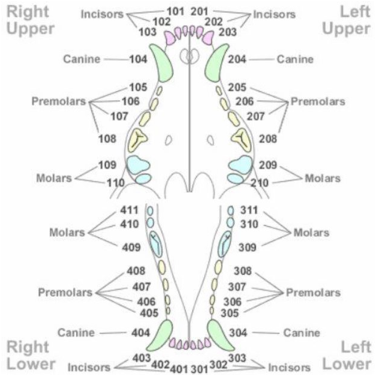
Puppy Teeth Time Line
3 – 8 Weeks 28 Primary (deciduous) teeth erupt, these teeth are all visible and it is important that all 28 teeth eventually fall out creating room for 42 permanent teeth. Dogs do not have molars during this period of tooth development, therefor the primary area of concern during the first 4 months is the front of the dog’s mouth. Puppies chew to relive the pain of teething. It’s important to keep a variety of things you want her to chew within reach of her mouth at all times. Chewing also releases endorphins in the puppy’s body, for this reason it is important dogs learn acceptable behaviors for what they can chew for pleasure later in life.
3 Months Incisors begin to fall out and the permanent incisors erupt this begins a stage when the dog has both deciduous and permanent teeth. A typical dog has six incisors on each of the lower and upper jaws. A dog’s body absorbs the roots of the puppy teeth as they fall out. Dog owners should be looking for signs of retained teeth at this stage, these signs include difficulty eating, swollen, red, bleeding gums around baby teeth, or abnormally-positioned permanent teeth.
4 Months Canines begin to fall out and the permanent canines erupt. The molars begin to erupt there are four premolars on each of the upper and lower jaws located directly behind the canines. Dog owners should now be looking visually for retained teeth. In puppies with a retained deciduous tooth, a permanent tooth is seen along-side the baby tooth it was meant to replace. The permanent canine teeth usually erupt in front of the deciduous canines.
6 -7 Months All adult molars are now visible, Dog owners should now be visually assessing the correctness of their dog’s bit. Signs of an improper bit include teeth that contact the roof of the dog’s mouth.
7 - 8 Months Final stage in a dog’s tooth development. A dog now should have 42 permanent teeth and their bit should look and operate normally. If an owner expects something is not right it is important to have veterinarian dentistry correct the problems before they cause irreversible damage to a dog’s mouth. For example, the normal growth of the jaw bone may be hindered by an abnormal teeth alignment. Also, teeth that are mis-aligned can make it difficult for the puppy to eat. They can also accidentally cause the puppy to bite the inside of the mouth, causing pain and potential infections.
One area that requires close monitoring is the growth and development of the puppy’s mouth and teeth. This is an area of the body where things can change very rapidly and if a problem goes unnoticed for some time, there may be permanent damage. Puppy teeth fall out allowing for their permanent teeth to develop correctly. Puppies are usually eight to twelve weeks old when they are taken to their new homes. Puppies should have a full set of primary or deciduous (baby, milk) teeth by the age of three months, these puppy teeth fall out over the next 4 months. Nevertheless if the deciduous tooth fails to develop by twelve weeks of age, it is likely the permanent tooth that should follow will not develop either.
Each quadrant of the mouth should have three incisors at the front, one long sharp canine tooth and then three pre-molar teeth behind the canines. As puppy teeth fall out owners should check their dog’s bit to ensure their puppies permanent teeth are coming in properly. Although puppy teeth fall out naturally a dog may benefit considerably from a tooth extraction to relieve malocclusion. Owners who monitor the proper schedule for their puppy’s teeth to fall out can avoid the conditions of crowded teeth; misaligned teeth; cross bite, overbite, under bite, open bite.
The summarized process permits owners a quick reference to monitor the process as puppy teeth fall out. Starting around three months of age, the developing permanent incisors should be erupting, and as they do, they should cause reabsorption of the roots of the deciduous incisors. Therefore, the puppy’s deciduous teeth become loose and fall out. This exfoliation of the deciduous teeth often goes unnoticed by the owners as the tiny crowns of the baby teeth are lost in toys or are swallowed. Next, the permanent canines start to erupt between four and five months of age, followed by the premolars and the molars. All the permanent teeth should have erupted by seven month of age in most dogs. If everything went according to the plan, by seven or eight months of age, all deciduous teeth will be gone, all permanent teeth will have erupted into the correct position and there will be no swelling or inflammation of the gums. Unfortunately, things do not always go according to the plan.
However, puppies born with a 'correct bite' will usually have a correct bite as an adult. Sometimes, around the age of 5 - 7 months a yorkies bite may become slightly undershot, overshot or level. But providing the puppy had a correct bite when it was born it should correct itself over the following few months as it matures (although it's not guaranteed to).
Yorkie should be strong, with a perfect, regular & complete 'scissor' bite.
A 'scissor' bite ('bite' refers to the teeth set within the jaw when the teeth are closed together) is when the upper incisors (front teeth) closely overlap the lower incisors and are set square in the jaw (also known as a 'perfect 6x6 scissor bite' - this refers to the 6 upper incisors and the 6 lower incisors).
Scissor Bite
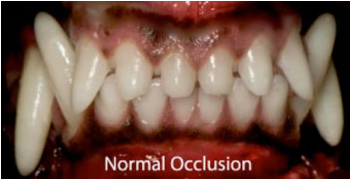

Jaw Abnormalities
Even when two adult Yorkies with perfect mouths have been bred together, one or more of the resulting puppies may have an incorrect mouth. Unfortunately, not all Yorkies mature to have a 'perfect scissor bite'.
Jaw abnormalities that can occur are: 'Undershot Jaw' (Bite), 'Overshot Jaw' (Bite) & 'Level Jaw' (Bite).
Puppies born with an incorrect bite are highly unlikely to gain a correct bite as they mature and will probably have the abnormality all of their life. Although, this tends not to affect the quality of life of the dog - it will be unsuitable for showing or breeding and the puppy should be rehomed as a 'pet only'
Undershot Jaw (undershot is where the lower jaw is longer than the top)
In a Yorkie with an 'undershot' jaw the lower incisors will be in front of the upper incisors. This is usually quite easy to spot, even without opening the dog’s mouth because the lower lip will be prominent of the upper lip in most cases. However, it always best to check the dogs mouth properly.
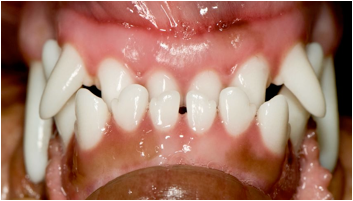
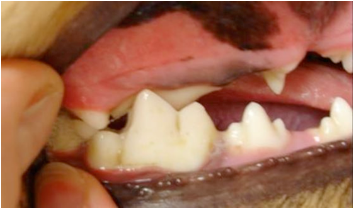
Overshot Jaw (overshot is where the upper jaw is longer than the bottom)
Conversely, an 'overshot' jaw is when the upper incisors are prominently in front of the lower incisors.
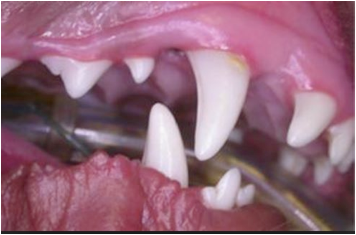
Level Jaw (upper incisors do not slightly overlap those in the bottom jaw)
In a 'level jaw' both the upper incisors and the lower incisors sit level (upper incisors lain directly on top of the lower incisors) in the mouth when it is closed.
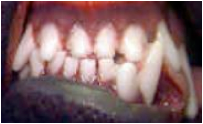
Retained Deciduous Teeth
Again, this is a problem that is frequently seen in the yorkie breed. However, if treated correctly, it need not be anything to worry about.
Retained deciduous teeth (or temporary teeth, ie; baby teeth) happen because the dogs’ permanent teeth do not dislodge the deciduous teeth like they should normally. This can lead to displacement or obstruction of the growing permanent teeth. Also, if left untreated, it can lead to overcrowding of the teeth in the dogs mouth. This in turn can lead to food becoming trapped between the permanent teeth and the deciduous teeth thus leading to potential periodontal disease (a disease that affects the gums and other tissues surrounding the teeth).
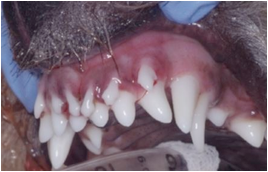
The image above shows the adult canine teeth growing beside (but inside) of the deciduous canine teeth (temporary canine) on both sides of the jaw (left to right).
In this case, it is just the canine teeth that are an issue. However, sometimes the permanent (adult) teeth can erupt in front or behind of all the deciduous (temporary) teeth. By doing so, they do not dislodge the temporary teeth as they should do normally - therefore, the temporary teeth are still retained within the jaw - thus, problems can develop if care is not taken during the transition stage.
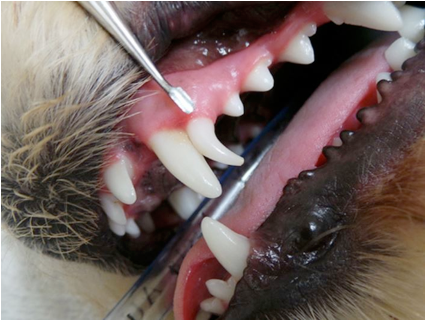
As a Yorkie puppy grows and begins to lose its deciduous teeth the mouth must be checked regularly to make sure things are progressing normally. At this stage some good dental chews may help dislodge any stubborn deciduous teeth. However, if this does not seem to be helping then a visit to the vets may be necessary to make sure your yorkies mouth is kept in 'tip-top' condition and to make sure all the permanent teeth grow healthily and normally.
A vet will remove the deciduous teeth if they are unwilling to come out on their own.
Helpful hints:
It is important to offer puppies various methods to relieve the pain from their teeth and gums during the teething period. A puppy should have access to different chew toys, this not only gives them something to chew it develops their ability to understand what is ok to chew and what they should not chew. Special chew toys that utilize ice offer the best relief from the swelling and inflammation puppies experience between 2 and 8 months of age.
I freeze a wet face cloth for the teething ones. They love to chew on them. It helps sooth their sore gums.
The importance of caring for the teeth
Do you have a puppy that is less than one year old? You can start
caring for your puppy's teeth as soon as they come home. Puppies,
however, must be trained to allow you to examine their mouth and brush their
teeth. It is a slow process, but if done gently, you will end up with an
adult Yorkie that doesn't mind having his teeth cleaned.
Do not use human toothpaste as it is likely to make your dog sick. Avoid
human toothpaste because it has Xylitol, a sweetening agent that is toxic to
dogs. Human pastes also have a foaming agent that is not necessary for our
dogs. A dog will swallow a lot of toothpaste while you brush so it is important
to use toothpaste designed for dogs.
The canine toothpaste is usually acceptable to dogs because it comes in flavors that dogs prefer such as beef, chicken, liver and even mint. If you prefer, you can use baking soda, but dogs may not take to it as easily as commercially prepared canine toothpaste.
A regular dog toothbrush can be used or a rubber finger brush that fits over your index finger and has soft knobs that break apart tarter as you rub your finger around the dog’s mouth.
A dog toothbrush is smaller than a human has and has softer bristles.
You can also use a piece of gauze that you wrap around your finger or a dental wipe purchased for that purpose. Dental rinses are also available, but they rarely remove all the plaque.
You will need a good canine tooth brush and a canine toothpaste. Beyond that, you might be interested in a dental spray.
While dental care is not likely to be on your bucket list of fun activities with dogs, your diligence will pay off and potentially lengthen the lifespan of your dog, prevent unnecessary visits to the veterinarian, keep your dog's canine teeth clean and mouth smelling fresh, and help your dog live a long happy life.
If you notice any of these problems in your dog's teeth, it is very
important to call and schedule a consultation with your veterinarian. If
your dog has tarter on his teeth and showing signs of disease, he may need a
professional cleaning in the veterinarian’s office.
Cleaning at a clinic is similar to that which we receive when we visit a dental
hygienist to have our teeth cleaned with one major exception.
Dogs cannot talk and tell the veterinarian where it hurts, and they cannot
sit in a chair willingly with their mouth open, canine patients must be
anesthetized for the veterinarian to get a good look and do a proper job.
Dental X-rays may be done and scaling and polishing are done while the dog is
monitored under anesthesia.